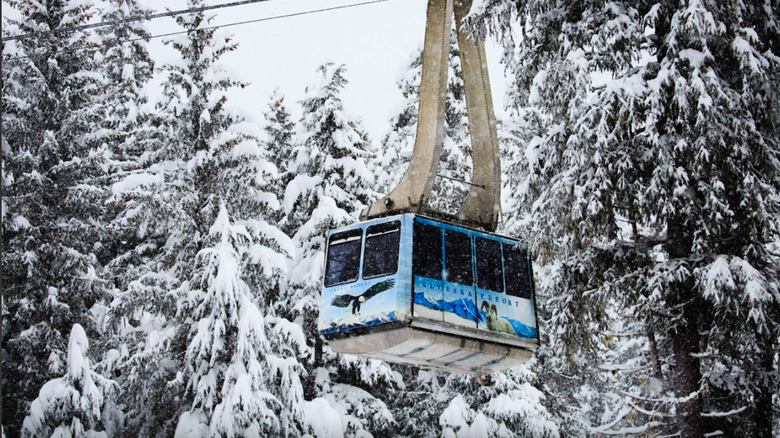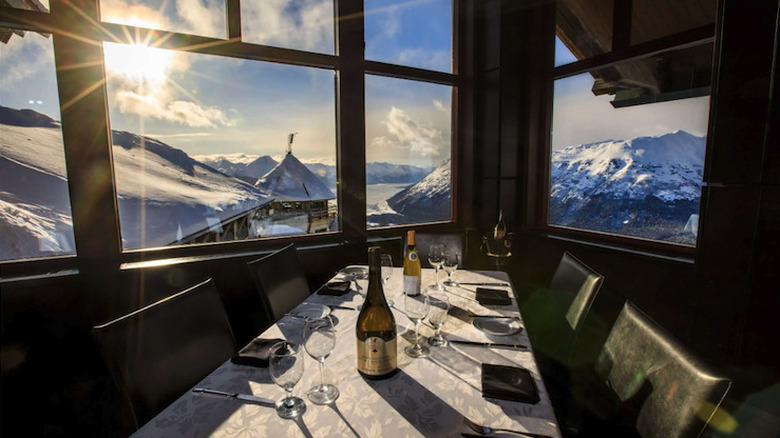The Glacier-View Alaskan Restaurant Only Accessible By Tram Lift
The term elevated dining takes on new meaning at an Alaskan outpost where an aerial tram whisks patrons to a site 2,300 feet above sea level. Offering both ocean and mountain views from its location near the summit of Mount Alyeska, part of Alaska's Chugach Mountain Range, the Seven Glaciers restaurant is named for the areas hanging glaciers — Crow, Raven, Eagle Clear, Goat, Milk, and Alyeska (via Alyeska Resort). These glaciers surround the town of Girdwood, which is just 40 miles south of Anchorage, and on a clear day, all seven of them are visible through the restaurant's panoramic windows (via Visit Anchorage).
The aerial tram sets off from its base at Alyeska Resort for the five-minute scenic ride to the restaurant. En route to the fine-dining experience that awaits, it passes high above Mount Alyeska's North Face Trail, which according to Unofficial Networks, is popular ski terrain for winter adventure-seekers. Upon arrival, guests board an elevator to the restaurant entrance where they pass by a glass-and-steel display wall showcasing the restaurant's extensive wine collection before entering the dining room (via Alaska.org).
The rustically elegant space, designed by Girdwood-based Z Architects, makes prime use of every angle, nook, and cranny to optimize the stunning mountain views through floor-to-ceiling windows. Dark wood accents give the Seven Glaciers dining room a cozy ambiance while well-placed sculptural elements — glacier-inspired wavy glass table separators and indigenous art — reflect the locale's wider surroundings.
Alaska on a plate
The kitchen at Seven Glaciers is one of just three AAA Four Diamond restaurants in the state, is the recipient of multiple Wine Spectator awards, and was named one of America's 100 Best Wine Restaurants in 2019. Chef de cuisine, Chris Hensel creates seasonal menus he described to Tasting Table as an "innovative interpretation of global fare with Alaska ingredients." His four-course prix-fixe menu relies on locally sourced ingredients representing three of the region's "main pillars," or natural resources: Chugach National Forest, Cook Inlet, and the Gulf of Alaska. "We strive to ensure the menus are adventurous but approachable with a focus on Alaska produce, seafood, and game that can be paired with world-class wines from our cellars," said Hensel.
A full round of courses from Seven Glaciers' winter menu could include scallop bisque (Kodiak weathervane scallop, chive oil, butter crouton, and caviar), Hot Rock (Cook Inlet salmon, champagne butter, and fried capers), a main course of bison filet mignon with charred leeks, potato pavé, red wine demi, and béarnaise compound butter, and chocolate caramel mousse bombe (cocoa nibs, caramel corn, brown butter snow, caramel sauce, and locally produced ice cream).
According to Hensel, the restaurant's dramatic presentation of salmon hot rock makes it a perennial favorite. The dish, prepared tableside, starts with locally sourced dry-aged Alaska salmon. The fish is served sashimi style on a hot rock collected from the bed of a river on the salmon's migratory route, then drizzled with champagne butter.

